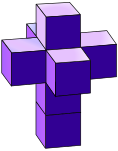File:Tesseract2.png
Tesseract2.png (212 × 263 pixels, file size: 55 KB, MIME type: image/png)
| This is a file from the Wikimedia Commons. Information from its description page there is shown below. Commons is a freely licensed media file repository. You can help. |

|
File:Tesseract2.svg is a vector version of this file. It should be used in place of this PNG file.
File:Tesseract2.png → File:Tesseract2.svg
For more information, see Help:SVG.
|
Summary
| DescriptionTesseract2.png |
English: Image of a three-dimensional net of a tesseract, created by Dmn with Paint Shop Pro.
The net of a tesseract is the unfolding of a tesseract into 3-D space. Let the dimension from left to right be labeled x, the dimension from bottom to top be labeled z, and the dimension from front to back be labeled y. Let coordinates by (x, y, z). Let the top cube have coordinates (0,0,1), the cube below it have coordinates (0,0,0), the cube in front of it have coordinates (0,−1,0), the cube behind it have coordinates (0,1,0), the cube to the left (−1,0,0), the one to the right (1,0,0). Let the cube below the central one have coordinates (0,0,−1) and the one at the bottom (0,0,−2). The central cube (0,0,0) is seen to be connected to six other cubes, but when folded in 4-D every cube connects to six other cubes. The frontal cube (0,−1,0) connects in the −Y direction to (0,0,−2), in the +Y direction to (0,0,0), in the +X direction to (1,0,0), in the −X direction to (−1,0,0), in the +Z direction to (0,0,1), in the −Z direction to (0,0,−1). There are twelve different ways in which the tesseract can be rotated (in 4-D) by 90 degrees in such a way that four of the cubes exchange positions cyclically while the remaining four cubes stay in place but rotate (in 3-D). For example, one 4-D rotation causes the following four-cube exchange: (0,0,1)→(0,0,0)→(0,0,−1)→(0,0,−2)→(0,0,1). Meanwhile, the same rotation causes cube (0,1,0) to rotate 90 degrees around the +X axis, the (0,−1,0) cube to rotate 90 degrees around the −X axis, the (1,0,0) cube to rotate 90 degrees in the −Y direction and the (−1,0,0) cube to rotate 90 degrees in the +Y direction. The twelve 4-D rotations are: Each 4-D rotation has a "dual" which is perpendicular to the 3-D rotation of the stationary cubes. There are six pairs of dual (4-D) rotations:
The dual of a 4-D rotation implies, by means of the right-hand rule, how the stationary cubes are supposed to rotate in 3-D. Since there are eight cubes and each cube connects to six other cubes, then each cube has a pair of cubes to which it does not connect: (1) itself, and (2) its opposite. Thus there are four pairs of opposite cubes: Each pair of opposite cubes aligns itself along opposite sides of one of four orthogonal axis of 4-D space. Therefore it is possible to establish a one-to-one onto mapping f between the unfolded positions of the cubes in 3-D and the canonical coordinates of their folded positions in 4-D, viz. The canonical 4-D coordinates have been given labels corresponding to basis quaternions (and their negatives). Using these labels, the 4-D rotations can be expressed more simply as All of these rotations follow a pattern A→B→−A→−B→A, so that each one can be abbreviated as an ordered pair (A,B). Then, each rotation can be abbreviated furthest as the product of the ordered pair of quaternions, which yields an imaginary quaternion: The pairs of dual quaternions are then seen to have the following properties: the products of their single-quaternion abbreviations are always unity:
|
| Date | |
| Source | Own work |
| Author | Dmn |
| Other versions | Tesseract2.svg, Tesseract net Crooked House.svg |
Licensing
| Public domainPublic domainfalsefalse |
| |
This work has been released into the public domain by its author, Dmn, at the English Wikipedia project. This applies worldwide. In case this is not legally possible: |
Captions
Items portrayed in this file
depicts
56,238 byte
263 pixel
212 pixel
image/png
b097f03608e75c653c77b1b2a8dd9ef95b556384
1 April 2007
File history
Click on a date/time to view the file as it appeared at that time.
| Date/Time | Thumbnail | Dimensions | User | Comment | |
|---|---|---|---|---|---|
| current | 09:14, 7 January 2006 |  | 212 × 263 (55 KB) | Anarkman~commonswiki | Image of a three-dimensional net of a tesseract, created by Dmn with Paint Shop Pro. The net of a tesseract is the unfolding of a tesseract into 3-D space. Let the dimension from left to right be labeled ''x'', the dimension from bottom to top be labele |
File usage
Global file usage
The following other wikis use this file:
- Usage on it.wikipedia.org










